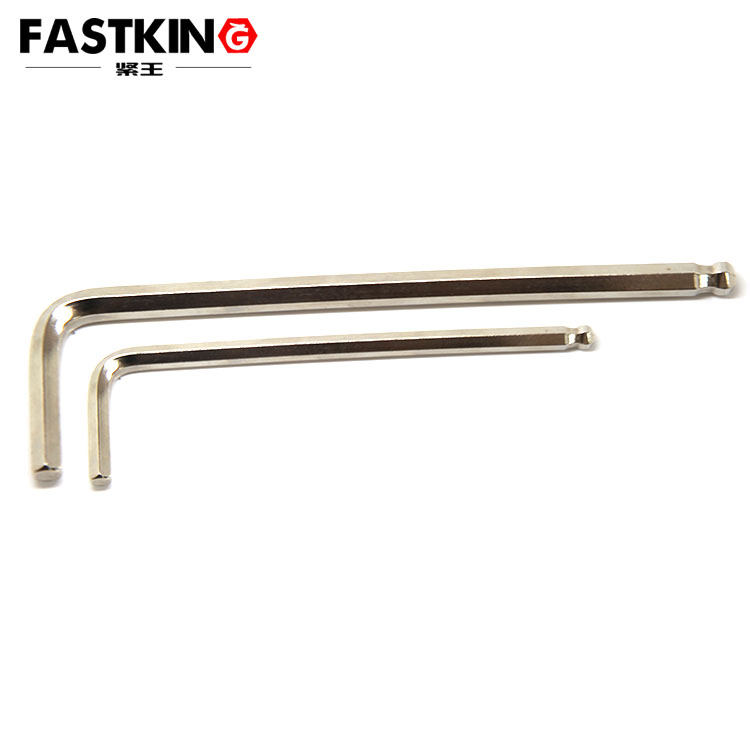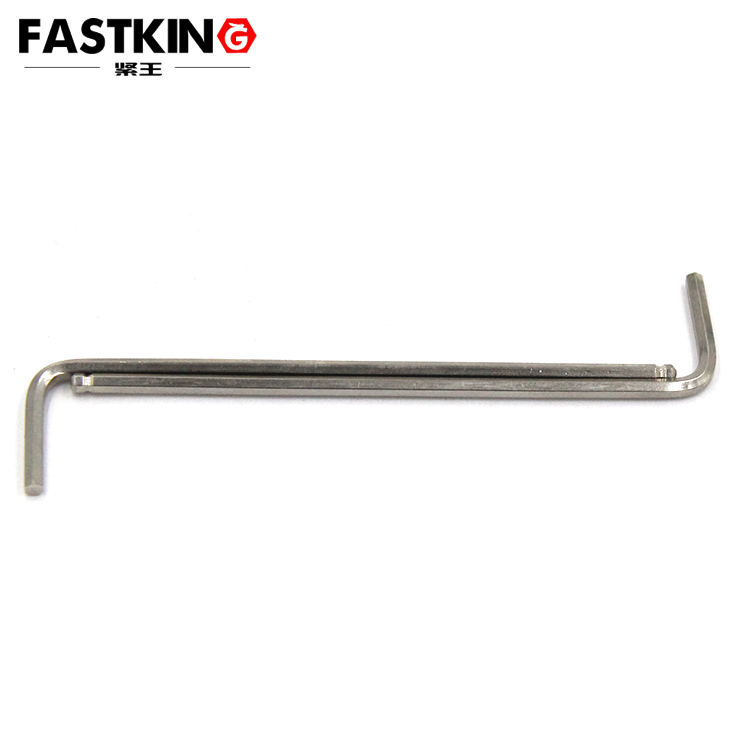- ZHUHAI JIALI HARDWARE CO.,LTD.
- +86-756-8586520
L style hex key with ball end
- Product description:L style hex key with ball end
L-type ball socket wrench
Material: stainless steel 304316, grade 8.8 high strength and grade 12.9 high strength
When the screw and the Allen key can not be placed in a straight line, the ball head can be used to screw.
It can also support non-standard customization.
In mechanical maintenance, equipment assembly, or home installation, we often encounter such a dilemma: hexagon socket screws are hidden in deep holes, corners, or component gaps, making it impossible for the screw axis to align in a straight line with the operating space. Straight-bar wrenches or flat-head hexagon socket wrenches cannot be inserted due to their fixed angles. Forced operation not only easily causes screw stripping but also may damage the screws or connected components. However, the L-type ball-head hexagon socket wrench, with its unique ball-shaped head design, perfectly solves the problem of "screws and wrenches being unable to be collinear". It has become a "savior" for fastening operations in complex spaces and plays an irreplaceable role in both professional fields and daily life.
I. Core Structure: Ball-Head Design Solves Angle Dilemmas
The basic structure of the L-type ball-head hexagon socket wrench is consistent with that of the L-type flat-head hexagon socket wrench—it has a 90° right-angle bent rod, divided into a "long handle" (10-25 cm, for easy force application) and a "short handle" (3-6 cm, suitable for narrow spaces). However, the key difference lies in the "head shape": its head is not flat but adopts a ball-shaped design with a radius matching the hexagon socket hole. The ball-head part can fit into the groove on the hexagon socket screw head and rotate flexibly within a certain angle range.
The core advantage of this ball-head design is "angle tolerance": ordinary flat-head hexagon socket wrenches require complete alignment with the screw axis (angle deviation ≤ 5°) to achieve stable fitting, while ball-head wrenches allow an angle deviation of 15°-30° (the specific angle varies slightly depending on specifications and materials). When the screw is located at the bottom of a deep hole, at a component corner, or blocked by other parts—making it impossible for the wrench to align with the screw in a straight line—the ball head can fit the screw head by tilting at an angle. The short handle can reach into narrow spaces, and the long handle can adjust the force direction from the outside. Disassembly and assembly can be completed without forced alignment with the axis, completely breaking the limitation of "straight-line operation".
In addition, the ball head and rod of high-quality L-type ball-head hexagon socket wrenches are still manufactured using an integrated forging process. The surface of the ball head undergoes precision grinding, with a roughness ≤ Ra 0.8 μm, which not only ensures a tight fit with the screw groove but also reduces friction loss during tilted rotation. The dimensional accuracy of the hexagon socket hole strictly complies with industry standards (common specifications range from 1.5 mm to 12 mm), and the hexagonal contour of the ball-head part is complete. This avoids uneven force caused by the special shape and ensures that the wrench is not easily deformed or broken when force is applied.
II. Working Principle: Dual Functions of Tilted Fitting and Flexible Force Transmission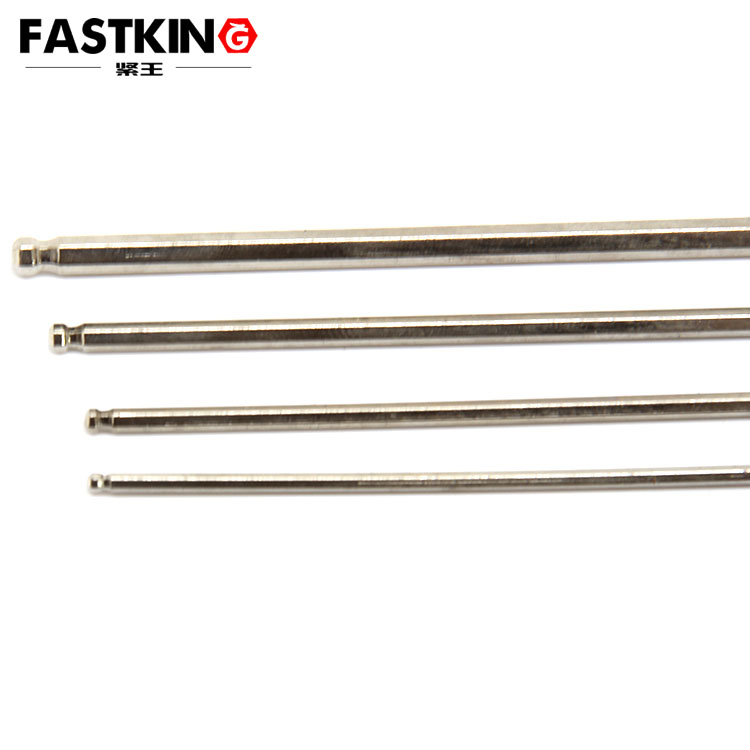

The fastening logic of the L-type ball-head hexagon socket wrench focuses on the "tilted fitting between the ball head and the screw groove" and "torque transmission through the rod", which can be specifically divided into three key steps: First, select a wrench of the appropriate specification according to the opposite side dimension of the screw, and align the ball head with the hexagon socket groove on the screw head—there is no need for strict alignment with the axis at this point; the wrench can be tilted by 15°-30° according to the operating space, and the curved surface of the ball head will automatically fit the inner wall of the groove to form a stable fitting structure. Second, choose to apply force with the long handle or short handle based on the space size: if there is sufficient external space, hold the long handle with your hand and apply torque using the lever principle; the ball head will evenly transmit the torque to the screw to drive it to rotate. If the space is narrow, insert the short handle into the deep hole or gap, tilt the long handle close to the component surface to apply force, and the ball head will flexibly adjust its angle in the groove to avoid collision with surrounding parts. Finally, after the screw is tightened or disassembled, simply rotate the wrench in the reverse direction—the ball head can be easily pulled out of the groove without additional angle adjustment, ensuring smooth and efficient operation.
It is worth noting that the angle deviation of the ball head is not unlimited: when the tilt angle exceeds 30°, the contact area between the ball head and the screw groove will be significantly reduced, and "point contact" (instead of "surface contact") is likely to occur, leading to concentrated force. This may cause wear to the ball head or stripping of the screw. Therefore, in actual operation, the tilt angle must be controlled within a safe range, and excessive torque should be avoided. For screws requiring high torque, it is recommended to first tighten the screw to a half-tight state using the ball-head wrench, then use a flat-head wrench or torque wrench to complete the final tightening—balancing flexibility and connection strength.
III. Application Scenarios: Focusing on Typical Needs of "Non-Straight-Line Operation"
The application scenarios of the L-type ball-head hexagon socket wrench almost all revolve around the core need of "screws and wrenches being unable to be collinear", and it performs particularly well in the following three types of scenarios:
1. Assembly of Deep-Hole and Concealed Screws
In automobile engine blocks, gearbox housings, or the box structures of industrial equipment, many hexagon socket screws are located at the bottom of deep holes (hole depth ≥ 10 cm), and the hole walls may have steps or chamfers—making it impossible for straight-bar wrenches to align with the screw axis after insertion. At this time, the short handle of the L-type ball-head hexagon socket wrench can reach into the deep hole, the ball head fits the screw head at a tilt, and the long handle applies force at a tilt outside the hole. The screw can be driven to rotate without fully inserting the wrench into the hole. For example, the fixing screws of the automobile gearbox oil pan have a hole depth of approximately 15 cm and are blocked by oil pipes around. The ball-head wrench can be operated at a 15° tilt angle to avoid collision between the oil pipes and the wrench while ensuring the screws are properly disassembled and installed.
2. Maintenance of Screws in Corners and Gaps
In furniture, home appliances, or electronic equipment, screws are often located at component corners (such as the connecting screws between wardrobe partitions and side panels) or component gaps (such as the fixing screws between the computer case motherboard and the power supply). The operating space only allows the wrench to be inserted at a tilt from the side. Taking the interior of a computer host as an example: the fixing screws between the graphics card and the motherboard are located under the graphics card, with a gap of only 5 cm and blocked by the memory module. A flat-head wrench cannot be inserted vertically, but the short handle of the L-type ball-head hexagon socket wrench can be tilted into the gap between the memory module and the graphics card. After the ball head fits the screw, the long handle is rotated outside the case to easily complete the disassembly and assembly of the screw—eliminating the extra step of removing the memory module.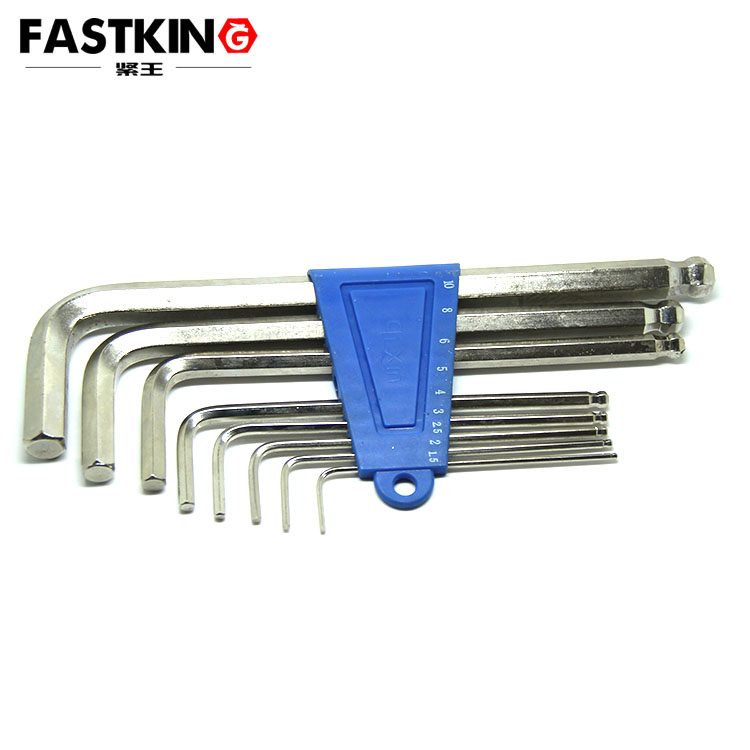

3. Multi-Angle Fine Adjustment of Precision Instruments
In precision equipment such as watches, cameras, and medical devices, miniature hexagon socket screws (specifications ≤ 3 mm) are often distributed in complex cavity structures, with extremely small operating spaces and variable angles. For example, the fixing screws of a DSLR camera lens are located in the gap between the lens mount and the camera body, with the axis forming a 20° angle with the camera shell. Ordinary wrenches cannot adapt to this angle, but the miniature ball head of the L-type ball-head hexagon socket wrench (such as the 1.5 mm specification) can be tilted into the screw groove. The short handle fits the inner wall of the camera body, and the long handle applies force for fine adjustment. This not only avoids damage to precision components but also accurately controls the tightness of the screw, ensuring the performance of the equipment is not affected.
IV. Materials and Processes: Ensuring Durability in Angle Operation
The selection of materials and processes for the L-type ball-head hexagon socket wrench must balance "strength for angle force transmission" and "wear resistance of the ball head". The common configurations are as follows:
In terms of materials, S2 tool steel or chrome-molybdenum alloy steel is preferred: After quenching and low-temperature tempering, S2 tool steel can reach a hardness of HRC 58-62, with excellent toughness—preventing the ball head from cracking when force is applied at a tilt. Chrome-molybdenum alloy steel has higher fatigue resistance, making it suitable for frequent angle operations. The surface of the ball head can maintain a complete contour even after long-term use, avoiding reduced fitting degree caused by wear. In contrast, ordinary carbon steel has lower hardness (HRC 45-50), and the ball head is prone to deformation when force is applied at a tilt for a long time—it is not recommended for professional or high-frequency operations.
In terms of surface treatment processes, in addition to conventional chrome plating for rust prevention, some high-end products adopt "nitriding treatment": a 5-10 μm nitrided layer is formed on the surface of the ball head, with a hardness of over HV 1000. This improves wear resistance by 3-5 times, reducing surface loss even when the ball head rubs repeatedly against the screw groove during tilted rotation. At the same time, the nitrided layer has better corrosion resistance than chrome plating, making it suitable for use in humid or oily environments (such as automobile maintenance and mechanical processing) and extending the service life of the wrench.
V. Usage and Selection: Details Determine Operational Safety
1. Usage Precautions
- Control the tilt angle: Strictly follow the safe angle range of "15°-30°" to avoid point contact between the ball head and the screw due to excessive tilt. It is recommended to observe the screw position before operation and mark the safe angle on the wrench rod with a marker pen to ensure the angle does not exceed the limit when force is applied.
- Prioritize matching specifications: The specification of the ball-head wrench must completely match the opposite side dimension of the screw. For example, an M3 screw corresponds to a 3 mm wrench. Even a 0.1 mm dimensional deviation will cause the ball head to fit loosely and easily lead to screw stripping when tilted. If the screw specification is uncertain, measure the opposite side dimension with a caliper before selecting the wrench.
-
Avoid over-torque operation: The torque-bearing capacity of the ball-head wrench is slightly lower than that of the flat-head wrench (approximately 80% of the flat-head wrench). For screws requiring a torque of ≥ 20 N?m, a torque wrench should be used in combination: first turn the screw with the ball-head wrench, then calibrate the torque with the torque wrench to prevent the ball head from breaking or the screw from being damaged.
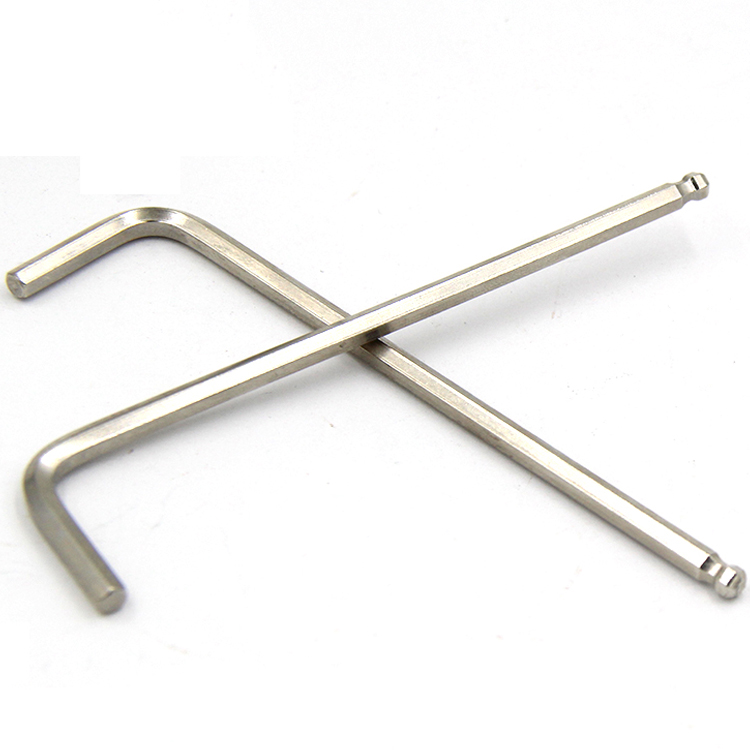
2. Key Selection Points
- Check ball-head precision: The ball head of a high-quality ball-head wrench has a clear hexagonal contour, no burrs on the hexagonal edges, and no unevenness when touched by hand. Insert the ball head into a standard hexagon socket gauge to check the fitting degree—the gap should be ≤ 0.03 mm to ensure even force application when tilted.
- Test rod toughness: Hold the long handle and short handle of the wrench, gently apply a bending force (≤ 5°), and the rod should return to its original shape without permanent deformation after releasing the force. If the rod is stiff or easily bent, it indicates insufficient material toughness, making it unsuitable for complex working conditions.
- Prioritize sets: For daily use, it is recommended to purchase a 10-12 piece set (including specifications from 1.5 mm to 12 mm). Sets are usually equipped with an angle instruction manual and a storage box for easy quick access to the corresponding specification. For professional scenarios, larger specifications (14 mm-19 mm) can be added to adapt to the screws of heavy-duty equipment.

